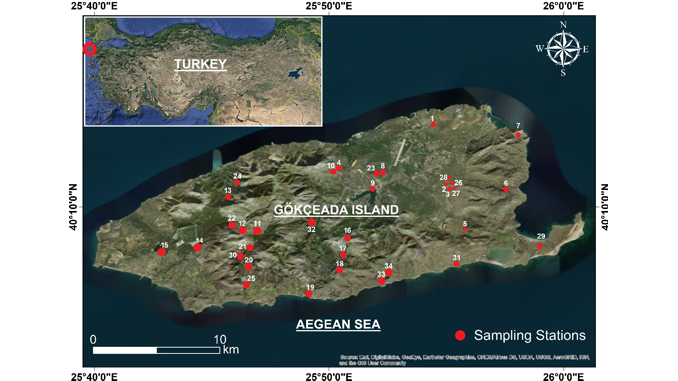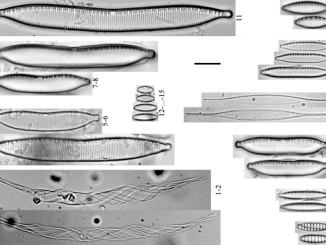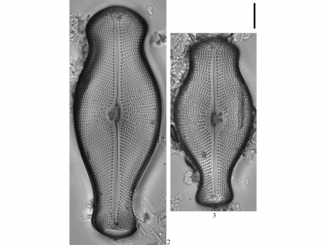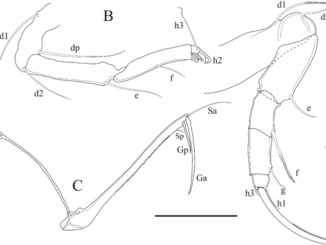
Paper category: Original research paper
Corresponding author: Serpil Odabaşı (serpilodabasi@comu.edu.tr)
DOI: 10.2478/oandhs-2021-0036
Received: 17/02/2021
Accepted: 06/04/2021
Full text: here
Citation (APA style): Odabaşı,S.(2021).Biodiversity of freshwater macroinvertebrates on Gökçeada Island (North Aegean Sea, Turkey). Oceanological and Hydrobiological Studies,50(4) 421-429. https://doi.org/10.2478/oandhs-2021-0036
Abstract
Island ecosystems have attracted the attention of scientists since the early days of science because of their formation and biodiversity. Despite their abundant freshwater resources, data on freshwater diversity of Gökçeada are incomplete, especially for macroinvertebrates. This study was conducted in a wide range of freshwater ecosystems on Gökçeada between May 2016 and September 2018. Sampling of macroinvertebrates was performed using a hand net from 34 pre-selected sampling sites on the island. A total of 78 aquatic macroinvertebrate taxa were found, 46 of which are new records for the island. The most common species during the study were Gammarus komareki and Bythinella gokceadaensis with a frequency of 25.93%, followed by Tubifex tubifex, Gammarus sp. and Caenis sp. with a frequency of 22.22%. Endemic and invasive species on the island were assessed according to their presence and frequency values. Based on the results of the current study and previous data, it can be concluded that Gökçeada is characterized by a remarkable species diversity compared to aquatic macroinvertebrates on other Aegean islands.
Acknowledgements
This study was financially supported by the Scientific Research Projects Unit (BAP-808) of Çanakkale Onsekiz Mart University, Turkey. I would like to thank Dr. Deniz Anıl ODABAŞI and Dr. Seçil ACAR who helped me during the fieldwork. I also would like to thank Dr. Emre ÖZELKAN for producing the map. I am also grateful to Dr. Belgin ELİPEK, Dr. Nurhayat DALKIRAN, and Elçin KEŞİR for their help with taxonomic identification. My special thanks go to the language editors Dr. Sercan Hamza BAĞLAMA and Dr. Ewa KAŹMIERCZAK, for their valuable corrections on the manuscript.
References
Aslan, H., Gönülal O., Can Yılmaz E., Çamur Elipek B., Baytut, Ö. et al. (2018). Species diversity in lentic, lotic, marine and terrestrial biotopes of Gökçeada Salt Lake Wetland (Çanakkale, Turkey). Fresenius Environmental Bulletin 27: 2853–2867.
Balık, S. & Ustaoğlu, M.R. (1993). A preliminary investigation on freshwater fauna of Gökçeada (İmroz) Island. Biologia Gallo-hellenica 20(1): 299–303.
Bank, R.A. (2004). Towards a catalogue and bibliography of the freshwater mollusca of Greece. Heldia 6: 51–85.
Benson, A.J., Raikow, D., Larson, J., Fusaro, A., Bogdanoff, A.K. et al. (2020, May). Dreissena polymorpha (Pallas, 1771). Gainesville, FL: U.S. Geological Survey, nonindigenous aquatic species database, http://nas.er.usgs.gov.
Bittkau, C. & Comes, H.P. (2005). Evolutionary processes in a continental island system: molecular phylogeography of the Aegean Nigella arvensis alliance (Ranunculaceae) inferred from chloroplast DNA. Molecular Ecology. 14(13): 4065–4083. DOI: 10.1111/j.1365-294X.2005.02725.x.
Çamur-Elipek, B. & Aslan, H. (2007). First observations of two talitrid crustaceans (Amphipoda: Talitridae) from Gökçeada Island (NE Aegean Sea). Mediterranean Marine Science 8(2): 83–87. DOI: 10.12681/mms.155.
Cengiz, T., Akbulak, C., Özcan, H. & Baytekin, H. (2013). Determination of optimal land use in Gökçeada. Journal of Agricultural Sciences. 19: 148–162. DOI: 10.1501/Tarimbil_0000001239.
Csabai, Z., Soós, N., Berchi, G.M., Cianferoni, F., Boda, P. et al. (2017). Aquatic and semiaquatic Heteroptera (Nepomorpha and Gerromorpha) fauna of Greek holiday islands (Rhodes, Crete and Corfu) with first records of three species from Europe and Greece. Zootaxa 4231(1): 051–069. DOI: 10.11646/zootaxa.4231.1.3.
Dvořák, L. & Georgiev, D. (2018). New and interesting records of Neuroptera from Samothraki Island, North Aegean islands, Greece. Parnassiana Archives 6: 3–6.
Ebbs, E.T., Loker, E.S. & Brant, S.V. (2018). Phylogeography and genetics of the globally invasive snail Physa acuta Draparnaud 1805, and its potential to serve as an intermediate host to larval digenetic trematodes. BMC Evolutionary Biology 18: 103–120. DOI: 10.1186/s12862-018-1208-z.
Eidinger, S., Mazacotte, G.A.L.M., Zdravković, D.S. & Lampou, A. (2016). Insights from stream ecological assessment on the Aegean island of Samothraki: aquatic chemistry and macroinvertebrate community. Sustainable Mediterranean, Integrated Management Approaches for biosphere Reserves and other designated Areas, 9–12 July, Summer University of Samothraki.
Falniowski, A. (2016). A new species of Pseudamnicola Paulucci, 1878 from Kithira Island, Greece. Folia Malacologica. 24: 69–74. DOI: 10.12657/folmal.024.011.
Georgopoulou, E., Glöer P. & Simaiakis S.M. (2016). Contribution to the freshwater gastropods of the island of Andros in the Northern Cyclades (Aegean Islands, Greece). Folia Malacologica 24: 275–286. DOI: 10.12657/folmal.024.023.
Glöer, P. & Hirschfelder, H.J. (2019). New freshwater molluscs from Crete, Greece (Gastropoda: Hydrobiidae, Bythinellidae, Valvatidae). Ecologica Montenegrina 20: 10–23. DOI: 10.37828/em.2019.20.2.
Glöer, P., Stefanov, T. & Georgiev, D. (2018). A new Pseudamnicola (Gastropoda: Hydrobiidae) from the Island of Limnos (Greece). Ecologica Montenegrina 19: 159–162. DOI: 10.37828/em.2018.19.16.
Hupało, K., Karaouzas, I., Mamos, T., & Grabowski, M. (2020). Molecular data suggest multiple origins and diversification times of freshwater gammarids on the Aegean archipelago. Scientific Reports 10:19813, www.nature.com/scientificreports. DOI: 10.1038/s41598-020-75802-2.
Kougioumoutzis, K., Thalassini Valli, A., Georgopoulou, E., Simaiakis, S.M., Triantis, K.A. et al. (2017). Network biogeography of a complex island system: the Aegean Archipelago revisited. Journal of Biogeography 44: 651–660. DOI: 10.1111/jbi.12920.
Lymberakis, P. & Poulakakis, N. (2010). Three continents claiming an archipelago: the evolution of Aegean’s herpetofaunal diversity. Diversity 2(2): 233–255. DOI: 10.3390/d2020233.
Móra, A. & Csabai, Z. (2008). First annotated checklist of Chironomidae of Rhodos, Greece (Insecta, Diptera). Spixiana 31(2): 223–231.
Odabaşı, S., Odabaşı D.A. & Acar S. (2019). New species of freshwater molluscs from Gökçeada Island (Northeastern Aegean Sea), Turkey (Gastropoda: Hydrobiidae, Bythinellidae). Archiv für Molluskenkunde 148(2): 185–195. DOI: 10.1127/arch.moll/148/185-195.
Özbek, M. & Özkan, N. (2017). Gökçeada içsularının Amphipoda (Crustacea: Malacostraca) faunası. Ege Journal of Fisheries and Aquatic Sciences. 34(1): 63–67. DOI: 10.12714/egejfas.2017.34.1.09.
Özkan, N. (2006). The larval Chironomidae (Diptera) fauna of Gökçeada (Imbroz). Gazi University Journal of Science 19(2): 69–75.
Poulakakis, N., Kapli, P., Lymberakis, P., Trichas, A., Vardinoyiannis, K. et al. (2015). A review of phylogeographic analyses of animal taxa from the Aegean and surrounding regions. Journal of Zoological Systematics and Evolutionary Research 53(1): 18–32. DOI: 10.1111/jzs.12071.
Radea, C., Parmakelis, A., Velentzas, A.D. & Triantis, K.A. (2016). Systematics of Pseudamnicola (Gastropoda: Hydrobiidae): description of two new species from insular Greece and redescription of P. pieperi Schütt, 1980. Journal of Molluscan Studies 82: 67–79. DOI: 10.1093/mollus/eyv031.
Reischütz, P.L. (1988). Beiträge zur molluskenfauna Thrakiens und Ostmakedoniens, II. –Annalen des Naturhistorischen Museums Wien. 90: 341–356.
Schütt, H. (1980). Zur Kenntnis griechischer Hydrobiiden. Archiv für Molluskenkunde. 110: 115–149.
Şahin, Y., Tanatmış M. & Küçük A. (1988). Gökçeada faunası Chironomidae larvaları. Anadolu Üniversitesi Fen Edebiyat Fakültesi Dergisi 1: 1–15.
Sarı, R., Türkecan A., Dönmez M., Küçükefe Ş., Aydın Ü. et al. (2015). Gökçeada’nın (Çanakkale) Jeolojisi. Maden Tetkik arama Dergisi 150: 1–17.
Szarowska, M., Hoffman, S., Osikowski, A. & Falniowski, A. (2014). Divergence preceding island formation among Aegean insular populations of the freshwater snail genus Pseudorientalia (Caeonogastropoda: Truncatelloidea). Zoological Science 31(10): 680–686. DOI: 10.2108/zs140070.
Szarowska, M., Osikowski, A., Hofman, S. & Falniowski, A. (2016). Pseudamnicola Paulucci, 1878 (Caenogastropoda: Truncatelloidea) from the Aegean Islands: a long or short story? Organisms Diversity & Evolution. 16: 121–139. DOI: 10.1007/s13127-015-0235-5.
Taylor, D.W. (2003). Introduction to Physidae (Gastropoda: Hygrophila). Biogeography, classification, morphology. Revista de Biología Tropical 51 Suppl 1:1–263, 265–287.
Zeybek, M., Koşal-Şahin S., Gönülal, O. (2017). Species Composition and Seasonal Distribution of Benthic Macroinvertebrates in Zeytinli Dam Lake (Çanakkale/TURKEY). The 3rd International Symposium on EuroAsian Biodiversity, 05–08 July 2017, Minsk–Belarus.



